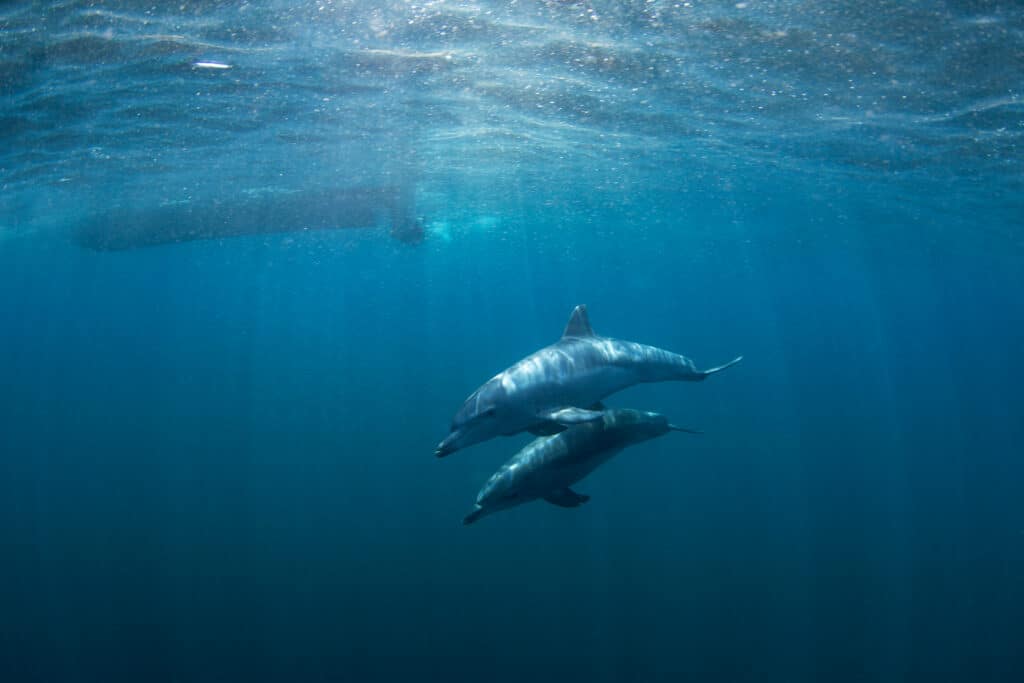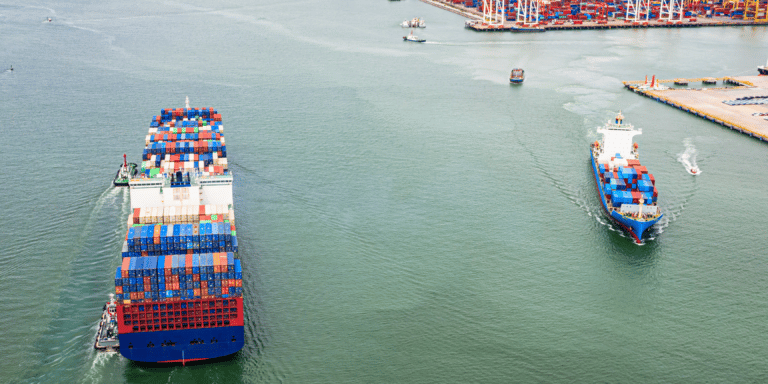The maritime transport business has done and is still doing huge efforts in order to reach its sustainable development goals. Pointed to be one of the major sources of pollution of all kinds, especially air and sea water pollution, the sector has huge efforts to reduce its carbon footprint and help fight against climate change. Multiple points still have to be addressed to achieve a green transition for the shipping industry.
What are the different kinds of environmental impacts of the shipping industry?
Carrying 90% of traded goods across the globe, ocean shipping is the primary transport mode. The business itself is an element of a cluster of activities done by a multitude of companies in all parts of the world. Together, they create huge added value and are considered a pillar of the global economy. But it also comes with a number of international-scale challenges, the main one being pollution.
According to the International Maritime Organization (IMO), the global maritime regulator, merchant ships are accountable for roughly more than 3% of the world’s greenhouse gas (GHG) emissions, with heavy consequences for the planet. And as the demand for sea freight is increasing due to the rapid growth of international trade, the volumes and traffic are expected to explode. Therefore, all the field players, from ship owners to port staff and authorities are required to take urgent and drastic measures to tackle the climate change issue.
Air Pollution
In a scenario of keeping global temperature increase below 2 degrees Celsius, and if other economic sectors fulfill their commitments to dropping their emissions, the maritime transport sector could still generate some 10% of worldwide GHG emissions by 2050.
This situation is generated by fuel burnt on board ships to produce energy, using processes that emit quite a lot of air-polluting elements known as by-products. Ship-source pollutants that are said to worsen climate change comprise carbon dioxide, nitrogen oxides, as well as sulfur oxides. In addition, black carbon particles formed during heavy fuel burning accounts for 21% of CO2-equivalent emissions from sailing vessels and are ranked the second most significant generator of shipping’s climate effects just after C02.
Emissions from ocean-going boats damage air quality and have adverse effects on human and animal health. According to IMO, without stringent measures to contain emissions from ships, GHG from sea transportation companies could record a 20% to 120% heightening by 2050, depending on economic context.
Water Pollution
All merchant ships (container vessels, bulk carriers, cruise ships, large tankers…) discharge an enormous quantity of ballast water during cargo unloading time. A variety of biological materials, including plants, animals, viruses, and bacteria are freed from that water. Research confirmed that there are non-native, pests and exotic, invasive species transferred to the sea, which causes extensive ecological damage to aquatic ecosystems, and consequently induces human health complications.
Another aspect of ballast release is the leaking of “blackwater” and “greywater”, which are very risky for both people and marine fauna and flora. This wastewater comes from toilets and medical facilities, and from cleaning activities aboard (showers, galleys, sinks, laundry…) respectively. As such, it can include harmful viruses, bacteria, pathogens, and other intestinal parasites altogether with some harmful nutrients, chemical pollutant substances, fecal coliforms, organic compounds, detergents, oil and grease, metals and petroleum hydrocarbons, food, medical and dental to name a few identified. Potential consequences are harsh: bacterial and viral contamination, and reduction of oxygen levels in the water, leading to marine life destruction.
Lastly, oil spill events have overwhelming effects because of oil toxicity to marine life. As it is very hard to clean up the polycyclic aromatic hydrocarbons (PAHs), components included in crude oil, they long-last in the sediment and marine environment. Any marine species exposed to PAHs can suffer developmental problems, abnormal reproductive cycles, or even fatal diseases.
Underwater Noise Pollution
Long-distance commercial ships produce extremely loud noise caused by their propellers and machinery. These noises have altered the ocean’s usual acoustic, disrupting marine species’ lives. Marine mammals, among others, indeed rely on sound for their orientation, communication, and feeding. Underwater noise pollution, therefore, challenges their ability to survive and prosper.

How are the maritime industry actors improving their environmental performance?
Tighten regulations
To reach the target set by the Paris agreement in terms of global heating and carbon emissions, the maritime trade has implemented new rules. In April 2018, the ruling body, IMO, arranged a draft greenhouse gas strategy for the sector to decrease emissions by at least 50% by 2050 compared to 2008 figures. The agreement mentions that the carbon intensity of global shipping should decrease with reductions in CO2 emissions per transport work, by a minimum of 40% by 2030, the ultimate goal is to attain 70% by 2050 from the 2008 baseline.
A set of short, medium, and long measures have been agreed upon in order to reach these goals, whilst some are still subject to the stakeholders’ negotiations. The next short-term measures cover the intensification of energy efficiency requirements for existing ships (EEDI), vessel speed optimization, and other technical and operational measures.
The modifications to the International Convention for the Prevention of Pollution from Ships (MARPOL) Annex VI approved in June 2021 by the 76th Marine Environmental Protection Committee (MEPC) summit are in force since 1 November 2022. The above-mentioned demands for EEXI and CII certification are applicable from 1 January 2023.
As a consequence, ships now have to monitor their energy performance by gauging their attained Energy Efficiency Existing Ship Index (EEXI). Vessel’s operational procedures must therefore provide the collection of all data needed for the calculation of the unit’s yearly operational carbon intensity indicator (CII) and the corresponding CII rating. As a reminder, carbon intensity relates greenhouse gas emissions to the volume of cargo transported over the distance sailed. The first annual reporting will be completed in 2023, so as to enable initial CII ratings sharing in 2024.
Improve air quality in ports and coastal areas
Emissions are a source of major problems for the air quality in ports and their immediate surroundings. A variety of solutions have been pursued, by the most important changes are expected from the below.
- Adopt Air Quality Monitoring Systems
Aligned with the global shipping industry efforts, ports have adopted air quality monitoring systems that provide real-time information data regarding control of air quality in their premises and surrounding areas. With this type of installation, port authorities continuously access reliable, accurate, and up-to-date information that benefits the community. In order to do so, the first step consists of identifying the root cause(s) of pollution.
Once these sources are identified, port managers and operators are able to reflect on means and ways to diminish pollution. For example, the port of Los Angeles possesses four air-monitoring stations that carry out real-time measurements of indicated key pollutants. Results help to take relevant decisions and to undertake appropriate actions. The reports issued by the U.S. Environmental Protection Agency (EPA) show significant air pollution improvement since 2005.
- Become a smart port
Digitalized ports are easily taking on environmental monitoring induced by increased activities. On their way towards sustainability, many of them are driving smart port projects, especially in advanced countries. There is no lack of examples: Hong Kong, Singapore, Spain (Valencia, Barcelona) France (Le Havre, Marseille), Belgium (Antwerp), The Netherlands (Rotterdam), Germany (Hamburg), Denmark and Sweden (Copenhagen-Malmö), the UK (London, Shoreham, Portsmouth), China (Shanghai, Tianjin, Ningbo, Qingdao), United States (New York, Los Angeles Savannah, Houston), Canada…
Technology adoption increases port efficiency combined with environmentally friendly air quality management. Overcrowded and congested ports automatically have their ambient air polluted. The higher number of ships operating in port or waiting to dock makes a higher percentage of pollutants in the air from burnt shipping fuel. However, a port adopting digital technologies to decrease vessel turnaround time will see air pollution levels drop and at the same time will improve its competitiveness.
The action plan for the transition to smart port takes in the package environmental monitoring systems for air, water, and noise.
- Reduce waiting time before berthing
The longer the ships wait at anchor, and use power for their basic needs, the more fuel emissions and pollutants are released. Lessening port congestion is another key to ensuring better air quality in ports and coastal areas. When updated ETA is regularly communicated between terminal tower controls and each ship, the latter can adjust its speed to be aligned with the said date and time so as to spend the shortest time possible at the port before its departure to its next destination. A centralized digital platform will facilitate communication and coordination between all actors within the maritime logistics chain before and during a port call.

Switch to clean fuels
Renewable electricity such as hydrogen and e-ammonia available now and is planned to be the next way to decarbonize the sector. Green energy, e-fuels are sustainable with a fast deployment to meet the growing needs.
However, there are other factors to consider such as high costs, even if the EU is working on solutions to increase production. If the EU suggestions are followed by the matching incentives for e-fuels, the demand could spread to 7% of the Union’s shipping fuel mix by 2030. This would put the sector on the right track to extensive use of renewable fuels and ultimately achieve net-zero emissions by 2050.
Liquid natural gas (LNG) is also a potential alternative to legacy heavy fuel oil (HFO) and marine gas oil (MGO) partially because LNG use can lower sulfur oxides by up to 100% and nitrogen oxides emissions by up to 90% compared to HFO. Also, some leaders and policymakers classify LNG as an “alternative fuel” that can accelerate the shipping sector’s decarbonization.
Yet, as per scientists, LNG delivers only up to 10% reduction of GHG emissions compared to the swapped diesel fuel without any methane leakage. This potential will likely be canceled out in absolute terms due to trade development, which directly leads to the rise of marine traffic.
Invest in innovative solutions
To conduct a strategy focused on people, efficiency, and environment, and achieve ambitious goals, the maritime industry actors must leverage innovation.
- Assess environmental impacts
To make the best of technology, any action shall start assessing and evaluating impacts and constantly monitoring improvements to maintain progress. Artificial intelligence, Big data, and the internet of things … could assist in tackling challenges pertaining to pollution. They are exploited in association with the huge amount of data transmitted by vessels’ Automatic Identification Systems (AIS) and by satellites.
For example, regarding underwater pollution, Sinay has developed an IA-based calculator dedicated to Sound Exposure Level (SEL) estimation. The fleet manager can use it to measure the amount of noise generated by any vessel for a specific journey. Thanks to an API, the tool’s integration with the client company’s own platform is very easy. Knowing its underwater noise impact, the latter can review the design and technical characteristics of the vessels, along with its internal processes so as to comply with the industry standards.
- Improve operational efficiency
Beyond carbon intensity decrease, digital tools can assist the maritime industry to grow its operational efficiency:
- dropping fuel consumption by slow route optimization combined with slow steaming;
- improvement port operations forecasting and management, coupled with real-time ETA;
- decrease port delays and maintenance costs;
- easier collaboration between stakeholders: shipping lines staff and agents, seaports and customs authorities, brokers, forwarders, inland haulage services providers, warehouses, importers, and exporters.
Conclusion
The global shipping industry is making progress in cutting the pollution created by the merchant fleet as it faces increasing pressure. However, there is still much to do to better exploit the opportunities offered by greener energy, new technologies, and reinforced regulation. Observers assign this gap partly to IMO’s slow procedures, where industry representatives serve on state delegations. Tough decisions have to be taken by the organization and its stakeholders, in cooperation with the United Nations Conference on Trade and Development, to align with the Paris agreement objectives. Surely the coming years will see more rigorous rules in order to attain the reduction targets set.
Frequently Asked Questions About Environmental Performance in the Shipping Industry
The maritime industry is responsible for a significant amount of greenhouse gas. According to IMO, merchant ships are accountable for roughly more than 3% of the world’s GHG emissions. The main sources of these emissions are fuel burnt on board ships.
Moreover, the shipping industry contributes to air pollution, water pollution, and underwater noise pollution. All of this increase climate change.
The main environmental impacts of the shipping industry include air pollution, water pollution, and underwater noise pollution.
The sources of air pollution in the shipping industry include emissions from ships burning fuel to produce energy, which emit elements that worsen climate change such as carbon dioxide, nitrogen oxides, and sulfur oxides.
Water pollution from the shipping industry releases an enormous amount of ballast water during cargo unloading, which contains various biological materials, including plants, animals, viruses, and bacteria, leading to ecological damage to aquatic ecosystems and human health complications.
Underwater noise pollution is caused by the extremely loud noise produced by long-distance commercial ships. This noise pollution alters the ocean’s usual acoustic, disrupting the lives of marine species that rely on sound for orientation, communication, and feeding.
The maritime industry is improving its environmental performance through tighter regulations, such as the draft greenhouse gas strategy implemented by the International Maritime Organization (IMO) to decrease emissions by at least 50% by 2050 compared to 2008 figures.
Focus on data to make effective decisions
Discover our modules
Environmental Monitoring
Monitor air quality in real-time, be alerted when a threshold is reached & easily comply with regulation thanks to the automated reports.
Monitor water quality in real-time, predict and avoid water pollution & comply with regulations thanks to the automated reports.
Deliver a preliminary metocean analysis and the associated report in jut a few minutes.
You may also be interested by those others environment application :






